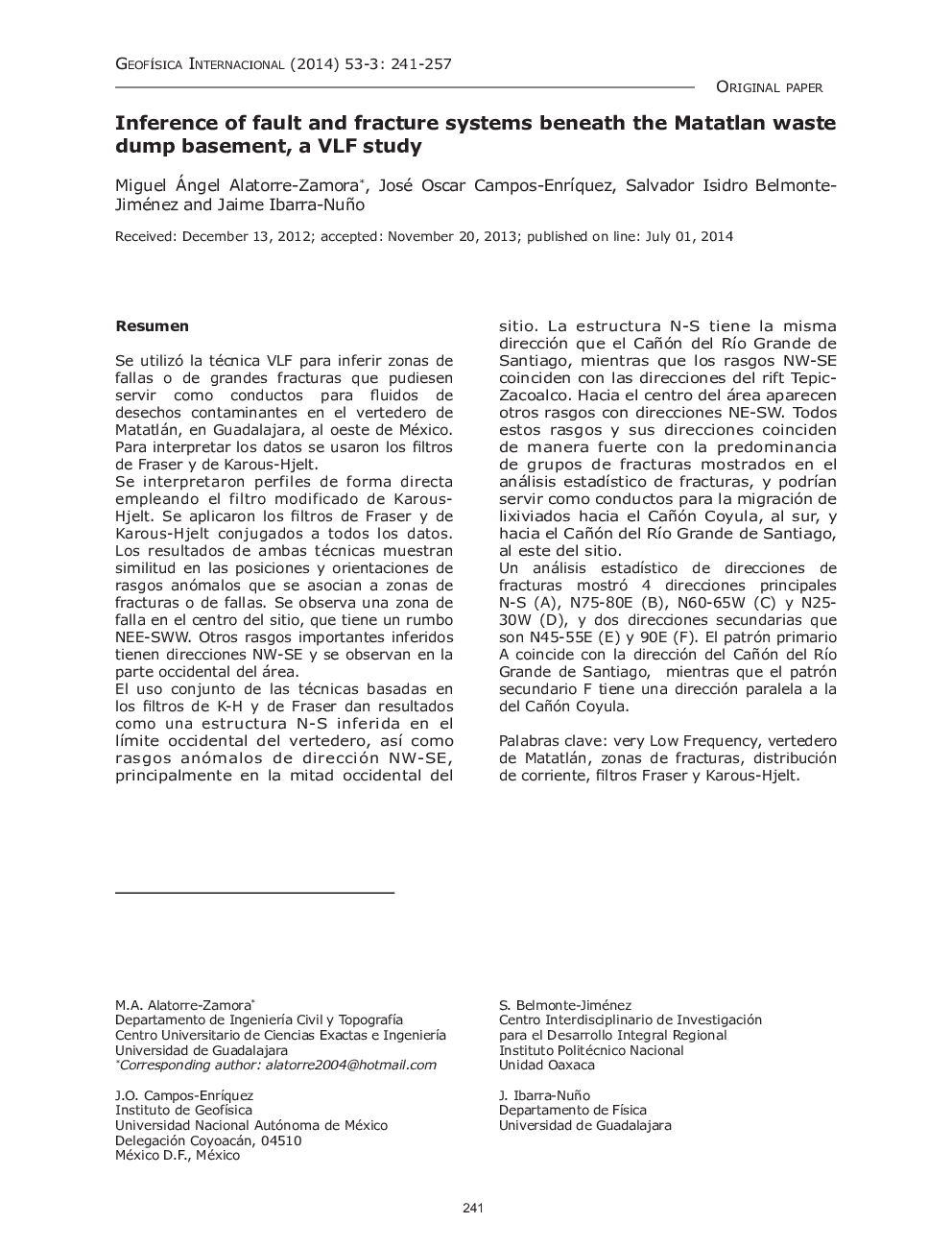| کد مقاله | کد نشریه | سال انتشار | مقاله انگلیسی | نسخه تمام متن |
|---|---|---|---|---|
| 4674376 | 1347151 | 2014 | 17 صفحه PDF | دانلود رایگان |

ResumenSe utilizó la técnica VLF para inferir zonas de fallas o de grandes fracturas que pudiesen servir como conductos para fluidos de desechos contaminantes en el vertedero de Matatlán, en Guadalajara, al oeste de México. Para interpretar los datos se usaron los filtros de Fraser y de Karous-Hjelt.Se interpretaron perfiles de forma directa empleando el filtro modificado de Karous-Hjelt. Se aplicaron los filtros de Fraser y de Karous-Hjelt conjugados a todos los datos. Los resultados de ambas técnicas muestran similitud en las posiciones y orientaciones de rasgos anómalos que se asocian a zonas de fracturas o de fallas. Se observa una zona de falla en el centro del sitio, que tiene un rumbo NEE-SWW. Otros rasgos importantes inferidos tienen direcciones NW-SE y se observan en la parte occidental del área.El uso conjunto de las técnicas basadas en los filtros de K-H y de Fraser dan resultados como una estructura N-S inferida en el límite occidental del vertedero, así como rasgos anómalos de dirección NW-SE, principalmente en la mitad occidental del sitio. La estructura N-S tiene la misma dirección que el Cañón del Río Grande de Santiago, mientras que los rasgos NW-SE coinciden con las direcciones del rift Tepic-Zacoalco. Hacia el centro del área aparecen otros rasgos con direcciones NE-SW. Todos estos rasgos y sus direcciones coinciden de manera fuerte con la predominancia de grupos de fracturas mostrados en el análisis estadístico de fracturas, y podrían servir como conductos para la migración de lixiviados hacia el Cañón Coyula, al sur, y hacia el Cañón del Río Grande de Santiago, al este del sitio.Un análisis estadístico de direcciones de fracturas mostró 4 direcciones principales N-S (A), N75-80E (B), N60-65W (C) y N25-30W (D), y dos direcciones secundarias que son N45-55E (E) y 90E (F). El patrón primario A coincide con la dirección del Cañón del Río Grande de Santiago, mientras que el patrón secundario F tiene una dirección paralela a la del Cañón Coyula.
We used the VLF technique to infer fault or major fracture zones that might serve as path for contaminant waste fluids in the Matatlan dumpsite, in Guadalajara, western Mexico. To interpret the data we used the Fraser, and Karous-Hjelt filters.Profiles were interpreted with 2D direct modeling based on Karous-Hjelt modified filter (K-H). The Fraser and Karous-Hjelt conjugated filter were applied to the entire data. The results of both techniques show similarities in the directions and positions of anomalous features, which are assumed fault or fracture zones. We observed one fault zone at the centre of the site, with a NEE-SWW strike. Other important inferred structures have NW-SE directions at the western part of the site.The cooperative use of both techniques, based on K-H filter and the Fraser filter give results as an N-S inferred structure in the westernmost part of the zone, as well as NW-SE linear anomalies, mainly in the western half of the site. The N-S structure has the same direction as that of Rio Grande de Santiago Canyon. The NW-SE features coincide with the directions of the Tepic-Zacoalco rift. Others NE-SW lineaments are located towards the centre of the area. These facts coincide strongly with the predominance of fracture groups show in the fracture analysis. The inferred structures could serve as conduits for the leachates to migrate towards the Coyula canyon as well as towards the Rio Grande de Santiago Canyon.Statistic analysis of fracture orientations showed N-S (A), N75-80E (B), N60-65W (C), and N25-30W (D) main directions, and N45-55E (E), and 90E (F) secondary directions. Group A coincides with the direction of the Rio Grande de Santiago Canyon, whereas pattern F have the same direction as Coyula Canyon.
Journal: Geofísica Internacional - Volume 53, Issue 3, July–September 2014, Pages 241–257